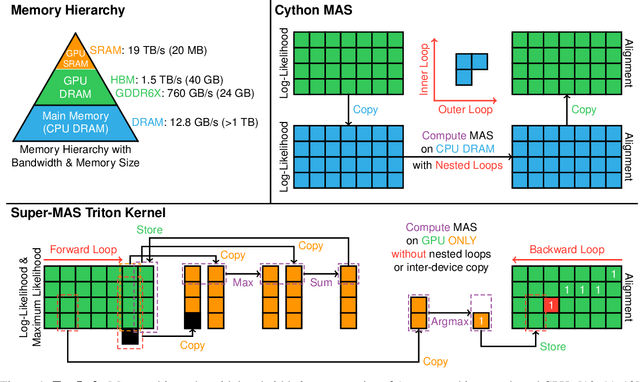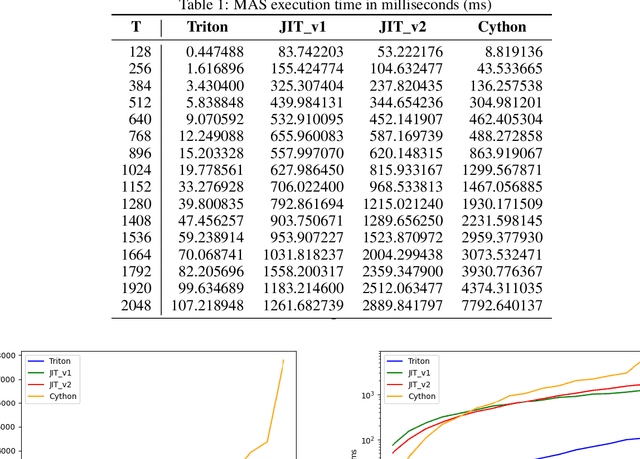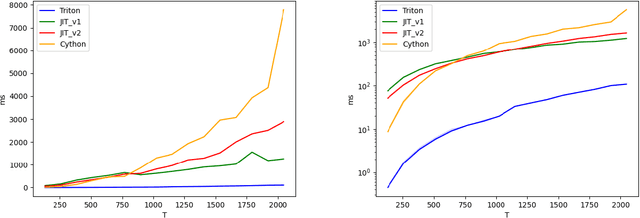Junhyeok Lee
Grouped Differential Attention
Oct 08, 2025Abstract:The self-attention mechanism, while foundational to modern Transformer architectures, suffers from a critical inefficiency: it frequently allocates substantial attention to redundant or noisy context. Differential Attention addressed this by using subtractive attention maps for signal and noise, but its required balanced head allocation imposes rigid constraints on representational flexibility and scalability. To overcome this, we propose Grouped Differential Attention (GDA), a novel approach that introduces unbalanced head allocation between signal-preserving and noise-control groups. GDA significantly enhances signal focus by strategically assigning more heads to signal extraction and fewer to noise-control, stabilizing the latter through controlled repetition (akin to GQA). This design achieves stronger signal fidelity with minimal computational overhead. We further extend this principle to group-differentiated growth, a scalable strategy that selectively replicates only the signal-focused heads, thereby ensuring efficient capacity expansion. Through large-scale pretraining and continual training experiments, we demonstrate that moderate imbalance ratios in GDA yield substantial improvements in generalization and stability compared to symmetric baselines. Our results collectively establish that ratio-aware head allocation and selective expansion offer an effective and practical path toward designing scalable, computation-efficient Transformer architectures.
Expanding Foundational Language Capabilities in Open-Source LLMs through a Korean Case Study
Sep 04, 2025Abstract:We introduce Llama-3-Motif, a language model consisting of 102 billion parameters, specifically designed to enhance Korean capabilities while retaining strong performance in English. Developed on the Llama 3 architecture, Llama-3-Motif employs advanced training techniques, including LlamaPro and Masked Structure Growth, to effectively scale the model without altering its core Transformer architecture. Using the MoAI platform for efficient training across hyperscale GPU clusters, we optimized Llama-3-Motif using a carefully curated dataset that maintains a balanced ratio of Korean and English data. Llama-3-Motif shows decent performance on Korean-specific benchmarks, outperforming existing models and achieving results comparable to GPT-4.
Improving Factuality of 3D Brain MRI Report Generation with Paired Image-domain Retrieval and Text-domain Augmentation
Nov 23, 2024



Abstract:Acute ischemic stroke (AIS) requires time-critical management, with hours of delayed intervention leading to an irreversible disability of the patient. Since diffusion weighted imaging (DWI) using the magnetic resonance image (MRI) plays a crucial role in the detection of AIS, automated prediction of AIS from DWI has been a research topic of clinical importance. While text radiology reports contain the most relevant clinical information from the image findings, the difficulty of mapping across different modalities has limited the factuality of conventional direct DWI-to-report generation methods. Here, we propose paired image-domain retrieval and text-domain augmentation (PIRTA), a cross-modal retrieval-augmented generation (RAG) framework for providing clinician-interpretative AIS radiology reports with improved factuality. PIRTA mitigates the need for learning cross-modal mapping, which poses difficulty in image-to-text generation, by casting the cross-modal mapping problem as an in-domain retrieval of similar DWI images that have paired ground-truth text radiology reports. By exploiting the retrieved radiology reports to augment the report generation process of the query image, we show by experiments with extensive in-house and public datasets that PIRTA can accurately retrieve relevant reports from 3D DWI images. This approach enables the generation of radiology reports with significantly higher accuracy compared to direct image-to-text generation using state-of-the-art multimodal language models.
Super Monotonic Alignment Search
Sep 12, 2024


Abstract:Monotonic alignment search (MAS), introduced by Glow-TTS, is one of the most popular algorithm in TTS to estimate unknown alignments between text and speech. Since this algorithm needs to search for the most probable alignment with dynamic programming by caching all paths, the time complexity of the algorithm is $O(T \times S)$. The authors of Glow-TTS run this algorithm on CPU, and while they mentioned it is difficult to parallelize, we found that MAS can be parallelized in text-length dimension and CPU execution consumes an inordinate amount of time for inter-device copy. Therefore, we implemented a Triton kernel and PyTorch JIT script to accelerate MAS on GPU without inter-device copy. As a result, Super-MAS Triton kernel is up to 72 times faster in the extreme-length case. The code is available at \url{https://github.com/supertone-inc/super-monotonic-align}.
DualSpeech: Enhancing Speaker-Fidelity and Text-Intelligibility Through Dual Classifier-Free Guidance
Aug 27, 2024


Abstract:Text-to-Speech (TTS) models have advanced significantly, aiming to accurately replicate human speech's diversity, including unique speaker identities and linguistic nuances. Despite these advancements, achieving an optimal balance between speaker-fidelity and text-intelligibility remains a challenge, particularly when diverse control demands are considered. Addressing this, we introduce DualSpeech, a TTS model that integrates phoneme-level latent diffusion with dual classifier-free guidance. This approach enables exceptional control over speaker-fidelity and text-intelligibility. Experimental results demonstrate that by utilizing the sophisticated control, DualSpeech surpasses existing state-of-the-art TTS models in performance. Demos are available at https://bit.ly/48Ewoib.
JenGAN: Stacked Shifted Filters in GAN-Based Speech Synthesis
Jun 10, 2024Abstract:Non-autoregressive GAN-based neural vocoders are widely used due to their fast inference speed and high perceptual quality. However, they often suffer from audible artifacts such as tonal artifacts in their generated results. Therefore, we propose JenGAN, a new training strategy that involves stacking shifted low-pass filters to ensure the shift-equivariant property. This method helps prevent aliasing and reduce artifacts while preserving the model structure used during inference. In our experimental evaluation, JenGAN consistently enhances the performance of vocoder models, yielding significantly superior scores across the majority of evaluation metrics.
Diversifying and Expanding Frequency-Adaptive Convolution Kernels for Sound Event Detection
Jun 08, 2024



Abstract:Frequency dynamic convolution (FDY conv) has shown the state-of-the-art performance in sound event detection (SED) using frequency-adaptive kernels obtained by frequency-varying combination of basis kernels. However, FDY conv lacks an explicit mean to diversify frequency-adaptive kernels, potentially limiting the performance. In addition, size of basis kernels is limited while time-frequency patterns span larger spectro-temporal range. Therefore, we propose dilated frequency dynamic convolution (DFD conv) which diversifies and expands frequency-adaptive kernels by introducing different dilation sizes to basis kernels. Experiments showed advantages of varying dilation sizes along frequency dimension, and analysis on attention weight variance proved dilated basis kernels are effectively diversified. By adapting class-wise median filter with intersection-based F1 score, proposed DFD-CRNN outperforms FDY-CRNN by 3.12% in terms of polyphonic sound detection score (PSDS).
LLM-Based Cooperative Agents using Information Relevance and Plan Validation
May 27, 2024



Abstract:We address the challenge of multi-agent cooperation, where agents achieve a common goal by interacting with a 3D scene and cooperating with decentralized agents under complex partial observations. This involves managing communication costs and optimizing interaction trajectories in dynamic environments. Our research focuses on three primary limitations of existing cooperative agent systems. Firstly, current systems demonstrate inefficiency in managing acquired information through observation, resulting in declining planning performance as the environment becomes more complex with additional objects or goals. Secondly, the neglect of false plans in partially observable settings leads to suboptimal cooperative performance, as agents struggle to adapt to environmental changes influenced by the unseen actions of other agents. Lastly, the failure to incorporate spatial data into decision-making processes restricts the agent's ability to construct optimized trajectories. To overcome these limitations, we propose the RElevance and Validation-Enhanced Cooperative Language Agent (REVECA), a novel cognitive architecture powered by GPT-3.5. REVECA leverages relevance assessment, plan validation, and spatial information to enhance the efficiency and robustness of agent cooperation in dynamic and partially observable environments while minimizing continuous communication costs and effectively managing irrelevant dummy objects. Our extensive experiments demonstrate the superiority of REVECA over previous approaches, including those driven by GPT-4.0. Additionally, a user study highlights REVECA's potential for achieving trustworthy human-AI cooperation. We expect that REVECA will have significant applications in gaming, XR applications, educational tools, and humanoid robots, contributing to substantial economic, commercial, and academic advancements.
LatentSwap: An Efficient Latent Code Mapping Framework for Face Swapping
Mar 02, 2024



Abstract:We propose LatentSwap, a simple face swapping framework generating a face swap latent code of a given generator. Utilizing randomly sampled latent codes, our framework is light and does not require datasets besides employing the pre-trained models, with the training procedure also being fast and straightforward. The loss objective consists of only three terms, and can effectively control the face swap results between source and target images. By attaching a pre-trained GAN inversion model independent to the model and using the StyleGAN2 generator, our model produces photorealistic and high-resolution images comparable to other competitive face swap models. We show that our framework is applicable to other generators such as StyleNeRF, paving a way to 3D-aware face swapping and is also compatible with other downstream StyleGAN2 generator tasks. The source code and models can be found at \url{https://github.com/usingcolor/LatentSwap}.
VIFS: An End-to-End Variational Inference for Foley Sound Synthesis
Jun 08, 2023Abstract:The goal of DCASE 2023 Challenge Task 7 is to generate various sound clips for Foley sound synthesis (FSS) by "category-to-sound" approach. "Category" is expressed by a single index while corresponding "sound" covers diverse and different sound examples. To generate diverse sounds for a given category, we adopt VITS, a text-to-speech (TTS) model with variational inference. In addition, we apply various techniques from speech synthesis including PhaseAug and Avocodo. Different from TTS models which generate short pronunciation from phonemes and speaker identity, the category-to-sound problem requires generating diverse sounds just from a category index. To compensate for the difference while maintaining consistency within each audio clip, we heavily modified the prior encoder to enhance consistency with posterior latent variables. This introduced additional Gaussian on the prior encoder which promotes variance within the category. With these modifications, we propose VIFS, variational inference for end-to-end Foley sound synthesis, which generates diverse high-quality sounds.
 Add to Chrome
Add to Chrome Add to Firefox
Add to Firefox Add to Edge
Add to Edge